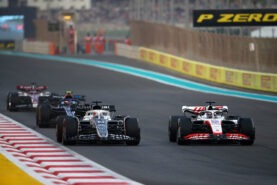Out brake

Kevin Magnussen driving the (20) Haas F1 VF-22 Ferrari and Pierre Gasly driving the (10) Scuderia AlphaTauri AT03 battle for position during the 2022 F1 Grand Prix of Abu Dhabi
Out brake, also known as outbraking or out-braking, is a term commonly used in Formula 1 racing to describe a driver's technique of braking later and harder than their opponent while approaching a corner, enabling them to gain an advantage and make a pass.
Braking is a critical aspect of racing, and drivers often push their limits to outperform their competitors. Outbraking involves a delicate balance of braking as late as possible while still maintaining control of the car and avoiding any collision. This technique requires precise timing, exceptional car control, and quick decision-making skills.
Outbraking can occur during overtaking, defending, or even during the start of the race. It is especially useful for overtaking, as the driver who outbrakes their opponent can gain a significant advantage and often secure a position change. This maneuver requires the driver to approach the corner at a higher speed than their opponent and brake later, enabling them to carry more speed through the corner and ultimately make a pass.
In some cases, outbraking can be risky, as braking too late can cause the car to slide or lose control, leading to a potential collision. Additionally, a driver can also be vulnerable to being outbraked themselves, as their opponent may anticipate the move and brake even later, making a successful pass on the driver who initiated the move.
Outbraking is a crucial component of successful Formula 1 racing, and drivers who can master this technique are often able to secure podium finishes and championship titles. It requires skill, experience, and a thorough understanding of the car's handling characteristics and braking capabilities. Overall, outbraking is a dynamic and exciting element of Formula 1 racing that adds to the thrill and excitement of the sport.











LAST 3 F1 Fan COMMENTS